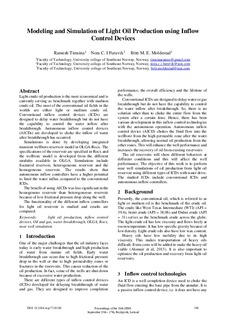| dc.contributor.author | Timsina, Ramesh | |
| dc.contributor.author | Furuvik, Nora Cecilie Ivarsdatter | |
| dc.contributor.author | Moldestad, Britt Margrethe Emilie | |
| dc.date.accessioned | 2017-12-13T12:12:24Z | |
| dc.date.available | 2017-12-13T12:12:24Z | |
| dc.date.created | 2017-10-11T17:45:26Z | |
| dc.date.issued | 2017 | |
| dc.identifier.citation | Linköping Electronic Conference Proceedings. 2017, (138), 180-187. | nb_NO |
| dc.identifier.issn | 1650-3686 | |
| dc.identifier.uri | http://hdl.handle.net/11250/2471150 | |
| dc.description.abstract | Light crude oil production is the most economical and is currently serving as benchmark together with medium crude oil. The most of the conventional oil fields in the worlds are either light or medium crude oil. Conventional inflow control devices (ICDs) are designed to delay water breakthrough but do not have the capability to control the water inflow after breakthrough. Autonomous inflow control devices (AICDs) are developed to choke the inflow of water after breakthrough has occurred. Simulations is done by developing integrated transient wellbore-reservoir model in OLGA-Rocx. The specifications of the reservoir are specified in Rocx and the wellbore model is developed from the different modules available in OLGA. Simulations include fractured reservoir, heterogeneous reservoir and the homogeneous reservoir. The results show that autonomous inflow controllers have a higher potential to limit the water influx compared to the conventional ICDs. The benefit of using AICDs was less significant in the homogenous reservoir than heterogeneous reservoir because of low frictional pressure drop along the well. The functionality of the different inflow controllers for light oil reservoir is studied and results are compared. | nb_NO |
| dc.language.iso | eng | nb_NO |
| dc.rights | Navngivelse-Ikkekommersiell 4.0 Internasjonal | * |
| dc.rights.uri | http://creativecommons.org/licenses/by-nc/4.0/deed.no | * |
| dc.title | Modeling and simulation of light oil production using inflow control devices | nb_NO |
| dc.type | Journal article | nb_NO |
| dc.type | Peer reviewed | nb_NO |
| dc.description.version | publishedVersion | nb_NO |
| dc.source.pagenumber | 180-187 | nb_NO |
| dc.source.journal | Linköping Electronic Conference Proceedings | nb_NO |
| dc.source.issue | 138 | nb_NO |
| dc.identifier.doi | 10.3384/ecp17138180 | |
| dc.identifier.cristin | 1503933 | |
| cristin.unitcode | 222,58,3,0 | |
| cristin.unitname | Institutt for prosess-, energi- og miljøteknologi | |
| cristin.ispublished | true | |
| cristin.fulltext | original | |
| cristin.qualitycode | 1 | |

